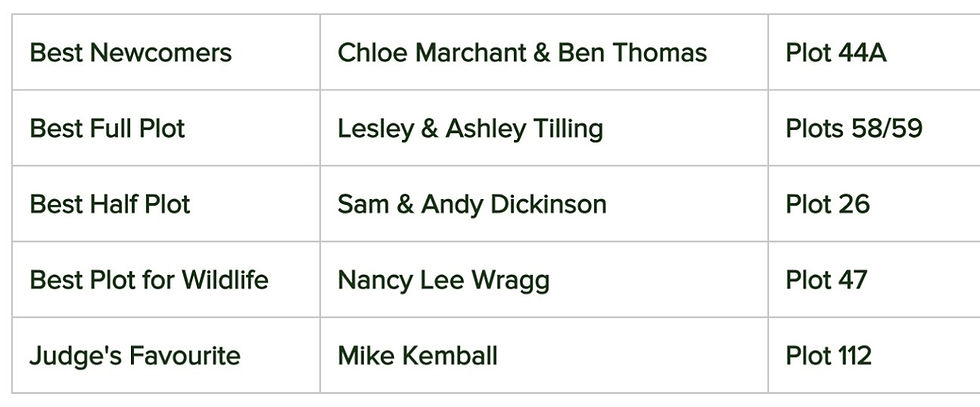2024 Plot Judging Winners & Judge's Hints and Tips
- Katie Bell

- Aug 25, 2024
- 4 min read
Updated: Aug 27, 2024

Plot judging took place on 30th July, with 16 members entering their plots. All entrants received their scoring forms along with helpful hints and tips from Julie Jacob. Julie has been our plot judge for the last three years. She has a lifetime of horticultural experience, is an instructor at RHS Merrist Wood and Kew, and also has her own allotment so understands the practical challenges of managing a plot.
Many congratulations to:

Here's a summary of the Judge's hints and tips:
Quality of produce
Space the plants appropriately, not too close, and train well
Examples: Courgettes 80cm to a metre, Sweet corn in a grid system
Ensure tomatoes have enough space for good air flow, and regularly pinch out side shoots of cordon tomatoes
Rather than squeeze every plant you’ve cultivated into the space, give away surplus to other plot holders or put on the sharing table
Nutrients
Look out for signs of chlorosis which is indicated by yellowing of the leaves indicating the plant is lacking chlorophyll
Apply a regular feed in the main growing season for annuals such as courgettes, tomatoes
For perennials such as raspberries and gooseberries to prevent chlorosis apply a general purpose feed early In the season, and apply a liquid feed if signs of nutrient deficiency are found
Crop Rotation
Plan for successional planting
Labelling - label where you can, even if it’s just to remember the cultivar, but knowing the date of planting is also helpful
Consider growing quick maturing crops such as beetroot, spring onions, baby carrots and leafy veg
Don't forget the winter season with chard, kale and other brassicas
Good cultivation
Structures
Make sure plants are appropriately supported
Netting needs to be the right mesh size
Net brassicas for butterflies
Net strawberries, sweetcorn and brassicas for birds
Net carrots for carrot fly - fine mesh
Ensure netting / mesh is generous enough to trail a little on the ground, and tied down securely to prevent birds and animals getting caught
Mulching
Mulch, mulch, and more mulch!
Particularly important on sandy soil to help retain moisture and nutrients
Fresh wood chip can be used on paths but not for beds.
After the wood chip on the paths has been down for a season you can use it on the beds and top up the paths with fresh wood chip
Leave a ring around the plants free of mulch to stop the plants rotting, particularly important for annuals
Don’t leave bare soil, try a green mulch, cardboard, composted manure, homemade compost or even grass clippings
Weeding
Keep the plot well-weeded to avoid competition for water
Julie took into account the ongoing issues with mares tail, couch grass and bind weed on the site
Trees
Prune fruit trees to ensure they remain productive - prune stone fruit trees in summer, others in the dormant period. Remove suckers from around the base of trees and any dead wood
Currant bushes need to be pruned in a goblet shape after fruiting
Blackberries fruit is on the previous years growth. In late autumn cut the stems that have fruited to the ground and tie up the new growth to structures
Range of Produce:
Try and grow a broad range of fruit and veg
Grow what you like to eat
Think about successional planting
If you have enough space think about growing perennial plants
Harvest when the produce is ready, don’t leave it to go over
Think about growing something you can’t get in the shops
Efficient use of the Plot
Make sure the paths are wide enough for good access for watering, weeding, harvesting
Avoid beds that are too small/big
Think about flexibility with the plot so crops can be rotated
Recycling and Composting
Composting:
Check your compost regularly to ensure it is actively composting
Make sure the compost in bins or bays doesn’t dry out
Fill one bin over a couple of months, then another
Make sure you harvest the compost
Recycling
Repurpose materials where you can
Collect water if you can. Particularly helpful if you grow blueberries which need to be watered with rain water
Wildlife
Flowers with open blooms such as daisies are good for pollinators
Sunflowers provide nectar, and the seeds feed birds, squirrels and mice
Lavender is great for bees, and buddleia for butterflies
Brambles and nettles are necessary for caterpillars (nettles make good liquid feeds)
Wood stacks are good for insects, wood lice etc
Keep sheds well-maintained to avoid getting animals trapped, make sure any chemicals, netting and other potentially hazardous materials are kept secure
Make sure netting over plants is kept well secured to avoid getting birds trapped.
If you have a tree, put up a bird box and/or bat box
Have a small pond if possible, make sure there is an exit route for small mammals, or insects that fall in. Make sure it's obvious where the pond is to avoid accidents
Overall presentation
A lot of the plots are clearly well-loved and maintained, not just those entered for judging
Plenty of interesting innovations for growing, such as a Christmas tree to support squash plants
Some health and safety concerns with chemicals open to the elements, sheds not secured properly etc
Plenty of trip hazards. Think about these, and what you can do to make your plot safe for all
****************************************









Comments